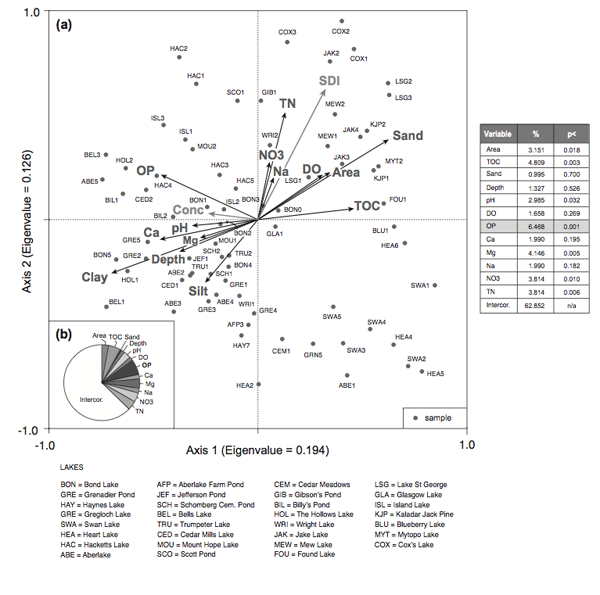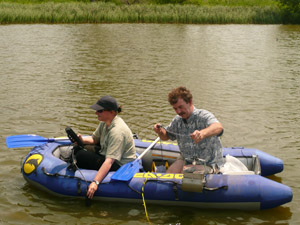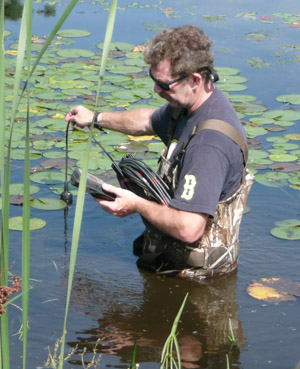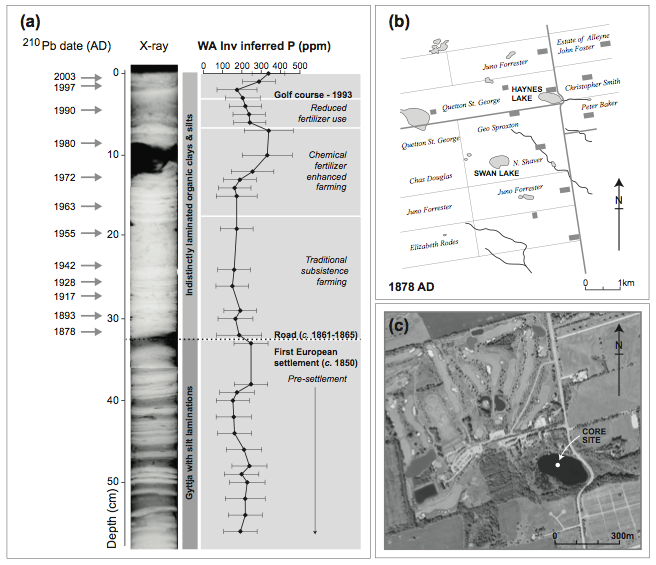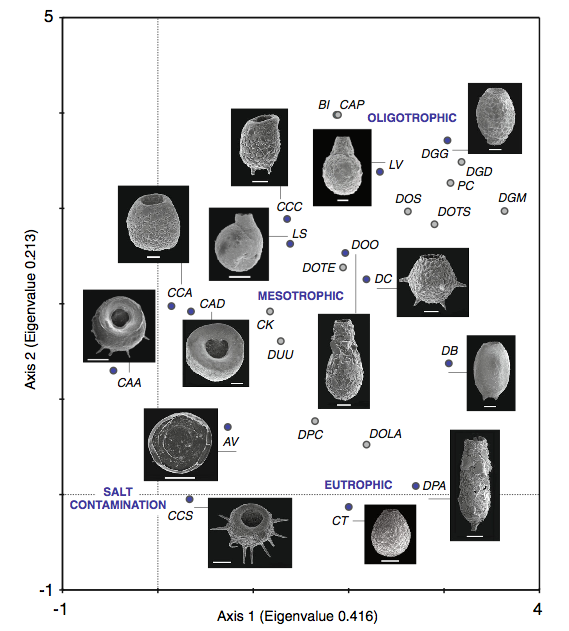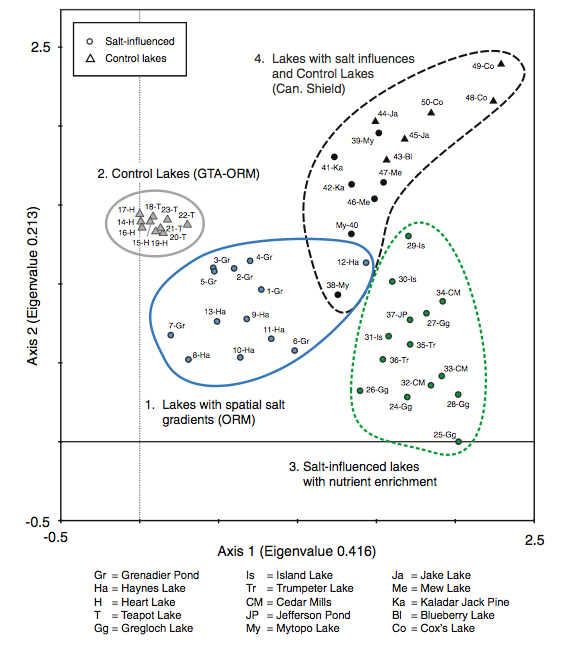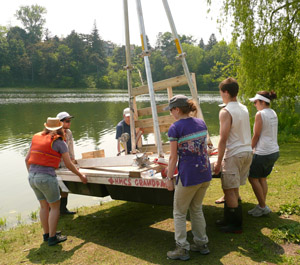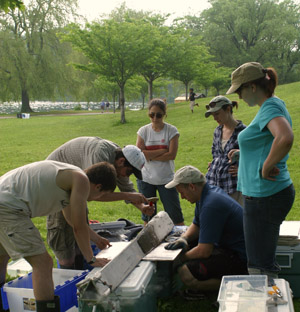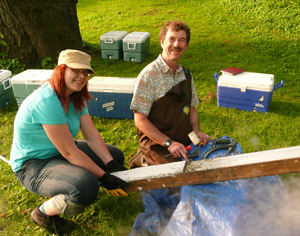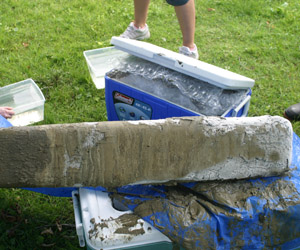
|
Return to Research Home Page The use of biological proxies in the detection and documentation of agricultural, industrial and residential land-use change makes an important contribution to environmental research. Arcellacea (also known as thecamoebians or testate lobose amoebate) are a diverse group of testate rhizopods that occur in a wide array of aquatic environments from lakes and ponds to peatlands and damp soils. Among this group agglutinating forms, primarily arcellacea, have tests that are highly resistant to decay and thus fossilize well, a characteristic that makes them particularly valuable as paleolimnological indicators.
Arcellaceans are particularly common in Holocene lacustrine and peatland environments from temperate to Arctic regions. Arcellaceans have been widely reported from lakes where variation in their faunal assemblages has been used to infer pH, oxygen, temperature, metal contamination and nutrient fluctuations. In spite of this work the ecology of lacustrine thecamoebians is poorly understood. This lack of progress has been in part related to the proliferation of species descriptions, which has resulted in considerable taxonomic confusion surrounding the group. This difficulty has come about as a result of most early systematic work being focused on creating new species of regional interest with little consideration for research elsewhere. As a result only a few studies have been carried out that have examined the full faunal response to environmental change in lacustrine environments. As a stop-gap measure an infra-subspecific classification system is used by many researchers whereby ecophenotypically useful variants are delineated by informal ‘strain’ names, which will suffice until a critical reanalysis of the more than 1500 species that have been described is carried out. There have been even fewer systematic studies carried out that test the response of thecamoebians to specific gradients (e.g. phosphorous loading, metal contamination, pH, temperature; road salt contamination. As a group thecamoebians nevertheless hold considerable potential for the detection of land-use change. Preliminary analysis of arcellacean faunas from nearly 100 lakes in urban and rural settings within the Greater Toronto Area (GTA), as well as from forested control areas in the Lake Simcoe area, Algonquin Park and eastern Ontario has been used by my group, and collaborators Dr. Helen Roe of Queen's University Belfast and Dr. Graeme Swindles, Leeds University, to develop a statistically rigorous thecamoebian-based training set for sedimentary phosphorus (Olsen P (OP)) loading.
We have been able to use the ordination results to derive a transfer function to reconstruct OP levels during the post-European settlement era (AD1870s onward) using a chronologically well-constrained core from Haynes Lake on the environmentally sensitive Oak Ridges Moraine, within the GTA. Ordination analysis indicated that OP most influenced thecamoebian assemblages.
The inferred reconstruction indicates that OP levels remained near pre-settlement background levels from settlement in the late AD 1870’s through to the early AD 1970’s. Since OP runoff from both forests and pasture is minimal, early agricultural land use within the lake catchment was as most likely pasture and/or was used to grow perennial crops such as Timothy-grass for hay. A significant increase in inferred OP concentration beginning ~AD 1972 may have been related to a change in crops (e.g corn production) in the catchment resulting in more runoff, and the introduction of chemical fertilizers. A dramatic decline in OP after ~AD 1985 probably corresponds to a reduction in chemical fertilizer use related to advances in agronomy, which permitted a more precise control over required fertilizer application. Another significant increase in OP levels after ~AD 1995 may have been related to the construction of a large golf course upslope and immediately to the north of Haynes Lake in AD 1993, where significant fertilizer use is required to maintain the fairways. These results demonstrate that thecamoebians have great potential for reconstructing lake water geochemistry and will complement other proxies (e.g. diatoms) in paleolimnological research. Ongoing research on the Oak Ridges Moraine and elsewhere will be carried out to refine the OP training sets and transfer function as well as to develop training sets for other environmental parameters (e.g. road salt as discussed below). Winter deicing operations occur extensively in mid- to high-latitude metropolitan regions around the world and result in a significant reduction in road accidents. Deicing salts can, however, pose a major threat to water quality and aquatic organisms. We have been assessing the utility of Arcellacea (testate amoebae) for monitoring lakes that have become contaminated by winter deicingsalts, particularly sodium chloride. We have been analyzing sediment samples and salt-related water property variables (chloride concentrations; conductivity) from lakes in the Greater Toronto Area and adjacent areas of southern Ontario. Lakes of interest include lakes in proximity to major highways and suburban roads, and control lakes in forested settings away from road influences. Samples from the most contaminated lakes, with chloride concentrations in excess of 400 mg/l and conductivities of >800 µS/cm, are dominated by species typically found in brackish and/or inhospitable lake environments and by lower faunal diversities (lowest Shannon Diversity Index values) than samples with lower readings. The findings thus far indicate that the group has considerable potential for biomonitoring in salt-contaminated lakes, and their presence in lake sediment cores may provide significant insights into long-term benthic community health, which is integral for remedial efforts.
Roe, H.M., Patterson, R.T., Swindles, G.T. 2010. Controls on the contemporary distribution of lake thecamoebians (testate amoebae) within the Greater Toronto Area and their potential as water quality indicators. Journal of Paleolimnology. v. 43, p. 955-975. DOI 10.1007/s10933-009-9380-1. Patterson, R.T., Roe, H.M., Swindles, G.T., 2012. Development of an Arcellacea (testate lobose amoebae) based transfer function for sedimentary phosphorus in lakes. Palaeogeography, Paleoclimatology, Palaeoecology. v. 348-349, p. 32-44.
|
![]()
Copyright T. Patterson 1996-2014
Carleton University
Updated:
April 16, 2014
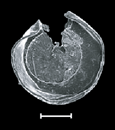 Arcella vulgaris
Arcella vulgaris Centropyxis aculeata strain 'spinosa'
Centropyxis aculeata strain 'spinosa'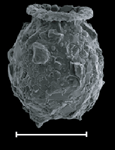 Difflugia urceolata strain 'urceolata'
Difflugia urceolata strain 'urceolata'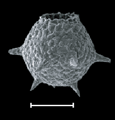 Difflugia corona
Difflugia corona
